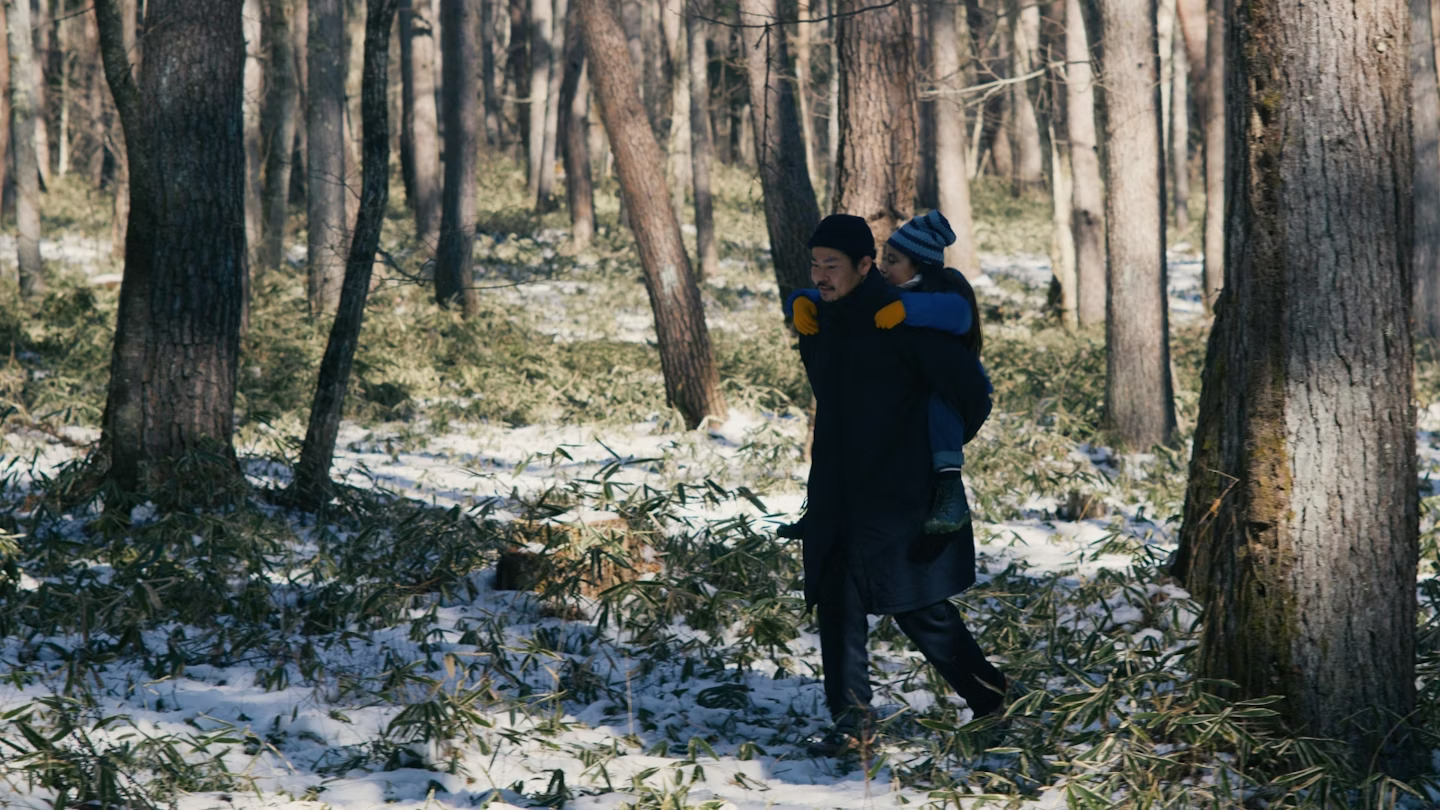Ryûsuke Hamaguchi won an Academy Award for Drive My Car based on a Haruki Murakami story. Suddenly after years of patiently making precise and complex cinema he was a “super star.” The same year his portmanteau feature Wheel of Fortune and Fantasy was released. Many people decided they were Hamaguchi experts. A piece of irony considering Hamaguchi will freely admit even he doesn’t quite know what Evil Does Not Exist is “about” – beyond its connection to the score by Iko Ishibashi which became a fully developed film.
The music is so essential that Ishibashi has a writing credit for the feature. It is the hypnotic roundelay which brings you into the town where Takumi (Hitoshi Omika) lives with his daughter, Hana (Ryo Nishikawa). Primary coloured block titles tell the audience little of what to expect. The opening is simply the music and the forest canopy. Drifting in a seemingly endless single take. We are in a Japanese forest. Is the forest comforting or sinister? We don’t know until we see the image of name in her primary-coloured outfit. Yellow mittens, blue parker. A child – not hunted – just curious. Yet, there was something ominous in the ten-minute sequence that should have been peaceful. Something is wrong but it is also pristine and beautiful. Therein lies the power of Ishibashi’s score.
In a small, forested community outside of Tokyo “gentrification” has not quite happened. Widower Takumi and Hana (Ryo Nishikawa) live a rhythmic existence. As the local “odd job man” Takumi knows every home and every aspect of the woods which sustain him and the town. He can identify specific roots and berries as edible. He collects pristine water for the local Udon restaurant and the abundant flavourings found growing wild. One of the rhythms is that Takumi is almost always late to pick up Hana who is roaming free in the woods – even in places she should not go.
The community and their relationship to the natural environment comes under threat because of a corporate land grab by a near non-existent company called Playmode whose intention is to create a glamping site in the woods. They have not thought about the environmental impact, and as they are run by a somewhat disgraced actor now talent scout now property owner. They have no firm idea as to how to even set up the camp beyond a very nice advertising package.
Takahashi (Ryuji Kosaka) and Mayuzumi (Ayaka Shibutani) are the onsite representatives for Playmode. They use their skills as “actors” to at least appear to be listening to the concerns of the community, but they have no answers because they are reading from a script. As each local raises concerns about wildlife, drainage, sewerage, staffing, fire safety, and how it will impact upon their livelihoods Takahashi can only repeat the company line that “Tourism is good for business.”
The Tokyo urbanites find they are outmatched by nature in more ways than they can imagine. Takahashi believes he can become a wild man and leave his unhappy life in Tokyo behind. Mayuzumi wants something in between – an escape from all aspects of her current predicament. The offices of Playmode are nothing but a basement room with an internet connection. On the drive to Mizubuki Village they reveal what their reality is. This section is pure Hamaguchi. Bitterness, sexism, ego, fecklessness, a woman having to deal with a man who only registers her as “female.” Mayuzumi’s boss has told her to amp up her passive version of Japanese womanhood to charm the locals – get them drunk. Perhaps that is why she is not only more sympathetic to the people of Mizubuki, but she also recognises what it is to be shaped and pruned by the expectation to conform to the urban.
The metaphors are many: farm animals in a cage, gut shot deer, the sounds of hunting in the background, Hana staring at a vulpine animal. Throw nature out of balance and there will be sacrifices. Although Hamaguchi seems to be deliberately opaque in some sections, he could not be more pointed in others. The director is consistently grappling with trying to find ‘Japan’ – and Evil Does Not Exist is the environmental fairy tale version of his country. Fairy tales do not always end up with a “Happily ever after,” as they are often warnings and stories about material reality. Sometimes someone ends up feeding a Juniper Tree.
Encroaching urbanisation and corporate destruction of the environment we inhabit is creeping violence. When nature is left to do what nature does, it does so without judgement or pity. It simply is. Things survive because they learn to rely on systems. The rhizome spreads. Sometimes it strangles the weaker species, sometimes it nourishes them.
Takumi, Hana, Takahashi, and Mayuzumi become avatars for the battleground that is the city versus the forest. Takumi isn’t simply the guide for Takahashi and Mayuzumi as he tries to make them understand what the wood has to offer, he is its protector. Takahashi becomes enamoured with the idea of becoming a version of Takumi and begins to indulge in hilarious and self-humiliating competitions to prove his manliness in front of Mayuzumi and Takumi. He is hubris believing that within a matter of days he can become a master of all he sees. Takahashi is urbanisation.
Mayuzumi admits to Takahashi there is something broken in her soul. From full-time healthcare worker, to actress, to an actress whose job it is to pretend to care, to one who genuinely might care – her sense of identity is shifting. If cultural malaise and ennui is represented it is through Mayuzumi.
Finally, there is Takumi the protector and Hana as the spirit of nature. Knowing nothing but the woods, her taciturn father who only comes to life when outside – she is the baby deer outsiders believe they can domesticate because she looks harmless. Behind the small creature there is a larger one – one who will instinctively turn to violence if their offspring is in danger.
In nature, and in life, there must be balance. The planet has tilted off its axis. Harmony with nature is a commodity that can be bought for a weekend – but it isn’t harmony, nor is it nature the glamping clients are seeking. They want the comforts of their contemporary lives to overwrite the natural world. There are only so many times the environment can be used as a palimpsest by humanity until it is permanently erased. Until all that is left is a sketch of a stream and the real predators. Trespassing and infecting like parasites leaving only husks behind.
Hamaguchi does not favour neat endings nor narratives that provide solutions to what it is to “be” anywhere or anyone. Evil Does Not Exist is a puzzle which has the pieces there to be put together, but some pieces will be too big or too small, or simply not quite the right shape to allow the audience to complete it.
Evil Does Not Exist is a beautifully shot philosophical treatise which prompts the audience to ask questions but doesn’t present the answers. What you get out of Hamaguchi’s dark fairy tale is that human nature and the natural world can’t be in sync if civilisation means destruction.
Haunting, ethereal, and bleak – Evil Does Not Exist again proves Hamaguchi as one of Japan’s most complex and indefinable storytellers.
Director: Ryûsuke Hamaguchi
Cast: Hitoshi Omika, Ryô Nishikawa, Ryûji Kosaka
Writer: Ryûsuke Hamaguchi, (Original concept by Ryûsuke Hamaguchi, Eiko Ishibashi)
Producer: Satoshi Takada
Music: Eiko Ishibashi
Cinematography: Yoshio Kitagawa
Editing: Ryûsuke Hamaguchi, Azusa Yamazaki
Streaming Availability:


